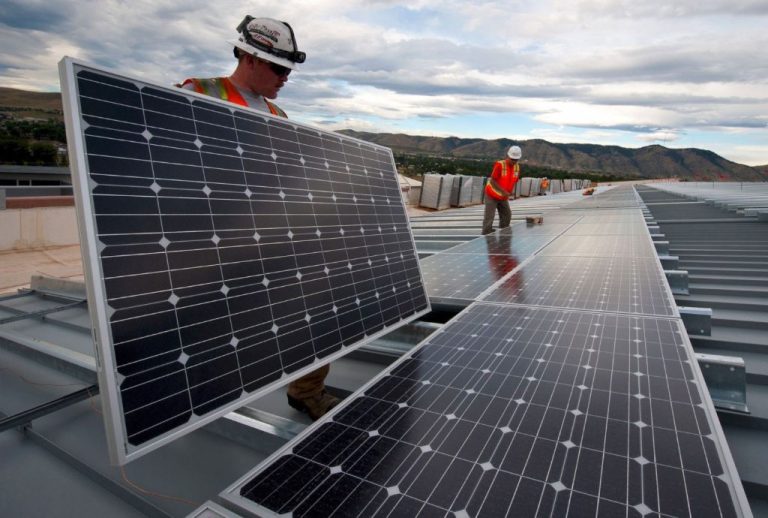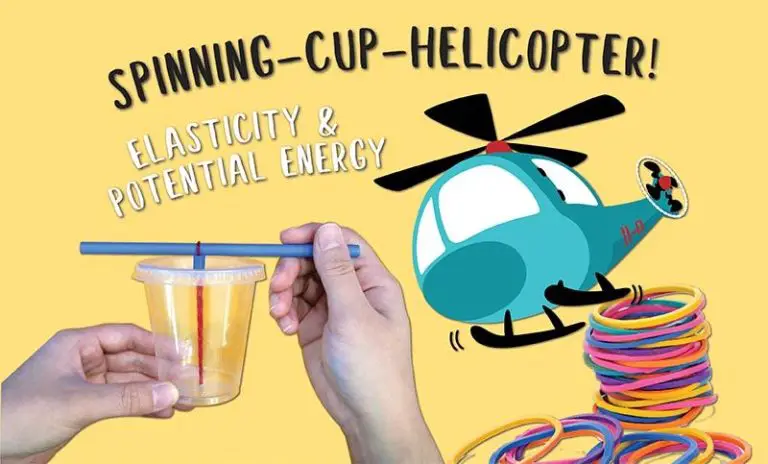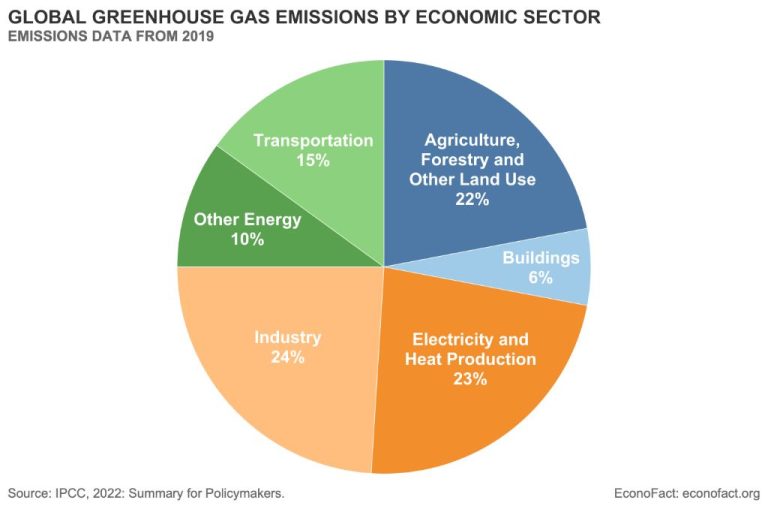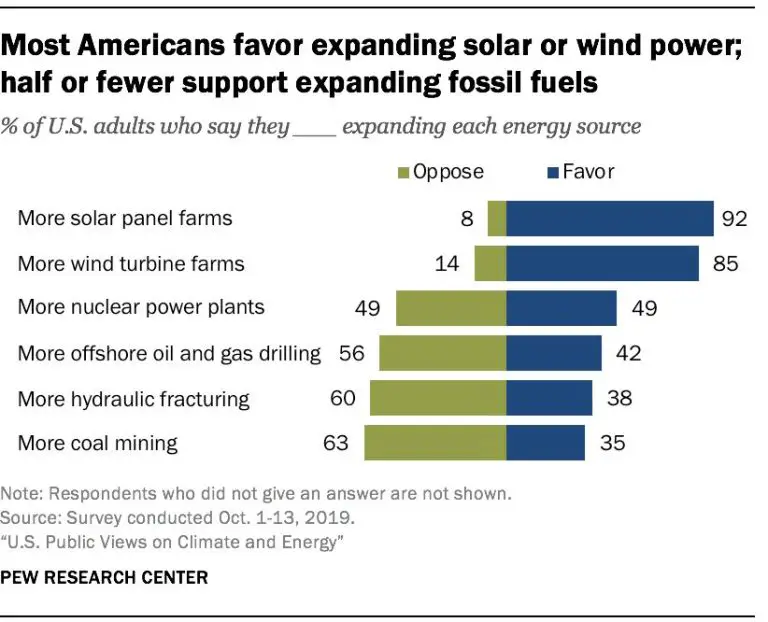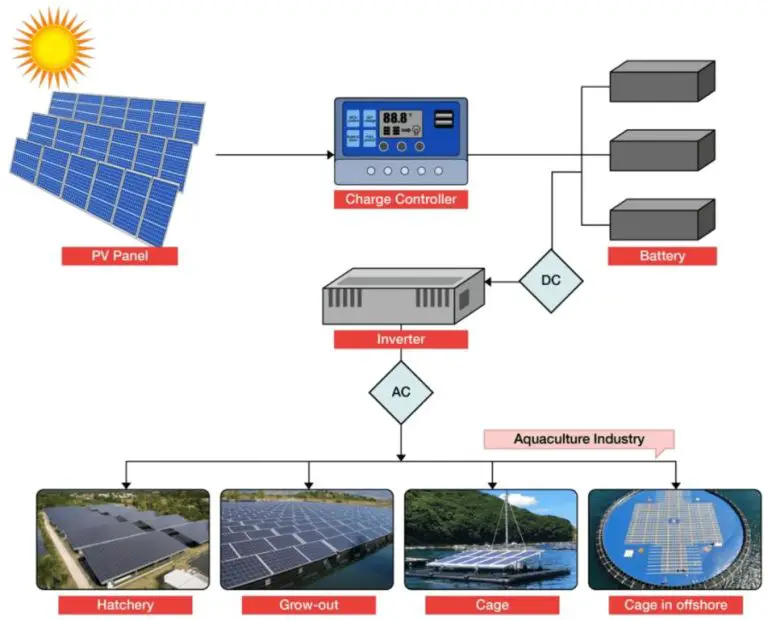What Is The Primary Purpose Of Photosynthesis?
Photosynthesis is the process that plants and certain organisms use to convert sunlight into chemical energy that can later be released and utilized for fuel. In its most basic sense, the primary purpose of photosynthesis is to convert solar energy into carbohydrates that can be used both as an energy source and to build plant structures.
During photosynthesis, plants, algae, and cyanobacteria absorb energy from sunlight to drive a series of chemical reactions that convert carbon dioxide and water into glucose molecules along with releasing oxygen as a byproduct. The glucose molecules produced provide energy for plants and are also the foundation to producing more complex carbohydrates like cellulose and starch that are used to build the structures of plants.
In summary, the main purpose of photosynthesis is to convert light energy into chemical energy in the form of carbohydrates that can power cellular activities and growth in photosynthetic organisms. This process is vital for sustaining plant life and providing the food sources that drive larger ecosystems.
Overview of Photosynthesis
Photosynthesis is the process by which plants, algae, and certain bacteria convert sunlight into chemical energy. During photosynthesis, organisms use the energy from sunlight to convert carbon dioxide and water into oxygen and energy-rich carbohydrates like sugars and starches.
The overall chemical equation for photosynthesis is:
6CO2 + 6H2O + Light Energy → C6H12O6 + 6O2
This means that the inputs for photosynthesis are carbon dioxide (CO2) and water (H2O), along with light energy from the sun. The outputs are oxygen (O2) and carbohydrates like glucose (C6H12O6).
The carbohydrates produced during photosynthesis are used by plants and other autotrophs to power cellular processes and drive growth. The oxygen released as a byproduct sustains most other forms of life on Earth that depend on it for cellular respiration.
In summary, photosynthesis harnesses the sun’s energy to convert carbon dioxide and water into the carbohydrates and oxygen needed to sustain nearly all life on Earth.
Harvesting Light Energy
The first step of photosynthesis is harvesting light energy from the sun. Inside plant cells are specialized organelles called chloroplasts, which contain the green pigment chlorophyll. When sunlight strikes chlorophyll, the energy from the light causes electrons in chlorophyll to become “excited” and jump to a higher energy level. These excited electrons contain energy that can be harnessed for photosynthesis.
At the heart of a chloroplast is the thylakoid membrane, which forms stacked, disc-shaped compartments called grana. Within the thylakoid membrane are chlorophyll molecules as well as proteins and enzymes that convert light energy into chemical energy through a process called the light-dependent reactions. When light strikes chlorophyll, electrons gain energy and are passed along an electron transport chain consisting of the proteins and enzymes. As the electrons flow down this transport chain, their energy is used to pump hydrogen ions from the thylakoid interior to the exterior. This creates a concentration gradient of hydrogen ions across the thylakoid membrane, which stores energy in the form of a chemiosmotic potential.
Later, this stored energy will be tapped to drive the production of carbohydrates and oxygen. So in summary, light energy is initially captured by chlorophyll pigments and converted into chemical energy in the form of the proton gradient through the light-dependent reactions in the thylakoid membrane.
Fixing Carbon Dioxide
The process of fixing carbon in photosynthesis occurs through a series of chemical reactions known as the Calvin cycle. This cycle enables plants to convert carbon dioxide from the atmosphere into carbohydrates that can be used both as an energy source and as the building blocks for plant structures.
The Calvin cycle takes place in the stroma of chloroplasts after energy from sunlight has been captured by chlorophyll and converted into chemical energy in the form of ATP and NADPH. The cycle can be broken down into three key steps:
- Carbon dioxide from the atmosphere diffuses into the chloroplast and combines with a 5-carbon sugar called RuBP. This initial fixation reaction is catalyzed by the enzyme RuBisCO and forms an unstable 6-carbon compound that immediately splits into two 3-carbon molecules called 3-PGA.
- ATP and NADPH from the light reactions provide the energy and electrons to convert 3-PGA into G3P, which contains high-energy bonds. This step reduces 3-PGA and forms the 3-carbon “backbone” of carbohydrates.
- Most of the G3P is converted back into RuBP so that the cycle can continue. One out of every six G3P molecules is removed from the cycle and combined into glucose and other carbohydrates that the plant needs.
By repeating this cycle, plants are able to take in carbon dioxide, harness energy from sunlight, and produce high-energy carbohydrate molecules. The efficiency of photosynthesis relies heavily on the carbon fixation reactions of the Calvin cycle.
Producing Carbohydrates
Photosynthesis produces carbohydrates for plants through a complex series of chemical reactions that convert carbon dioxide and water into sugars. This process takes place in the chloroplasts of plant cells, which contain the green pigment chlorophyll. When sunlight energy is absorbed by chlorophyll, it excites electrons which are then transported in an electron transport chain. This creates a proton gradient which powers ATP synthase to produce ATP. ATP provides the chemical energy needed to fix carbon. The enzyme RuBisCO captures carbon dioxide and attaches it to a 5-carbon sugar called RuBP. This forms an unstable 6-carbon compound that immediately splits into two 3-carbon molecules of glyceraldehyde-3-phosphate (G3P). Multiple G3P molecules are rearranged by additional enzymes to produce various sugars such as glucose, sucrose, and starch. These carbohydrates not only provide structure to plants, but also represent stored chemical energy that can be used for growth, metabolism, and other cellular processes. In summary, the intricate process of photosynthesis harnesses solar energy to synthesize carbohydrates from carbon dioxide and water, fulfilling the energy and molecular building block needs of plants.
Providing Chemical Energy
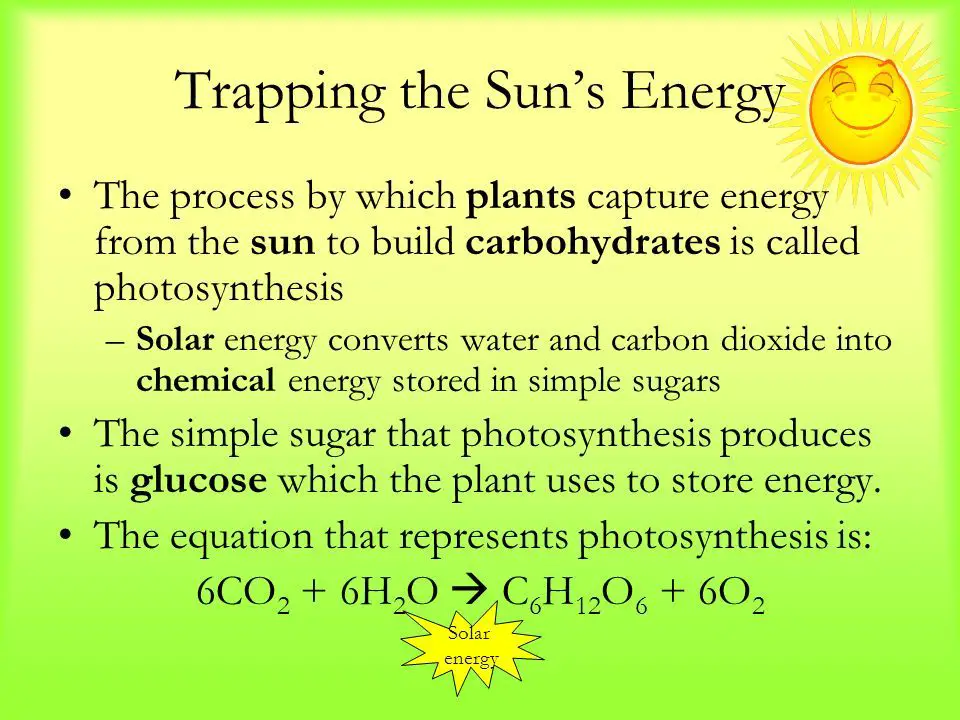
Photosynthesis serves a crucial role in providing chemical energy to plants and algae. During the light-dependent reactions, energy from sunlight is captured and used to generate ATP (adenosine triphosphate), a molecule that acts as the main energy currency in cells. The process that generates ATP is called photophosphorylation. Here’s how it works:
When sunlight hits the chlorophyll in photosynthetic organisms, the energy excites electrons in the chlorophyll molecules. These energized electrons get transported through an electron transport chain, which uses the electron energy to pump hydrogen ions (protons) across a membrane. This pumping builds up a proton gradient, which stores energy that can be tapped to power cellular processes.
The protons flow back across the membrane through an enzyme called ATP synthase. This flow of protons causes the ATP synthase to spin like a molecular motor, and in the process it catalyzes the formation of ATP from ADP and inorganic phosphate. Through this photophosphorylation process, the light energy captured by chlorophyll is converted into chemical energy in the form of ATP molecules.
The ATP generated through photosynthesis is a versatile energy carrier used to power critical cellular reactions, including the Calvin cycle reactions that make sugars. In this way, sunlight energy is transformed into chemical energy that powers plant growth and metabolism. Without photosynthesis, ecosystems would have no access to the chemical energy that sustains most life on Earth.
Releasing Oxygen
Photosynthesis has an extremely beneficial byproduct for many life forms on Earth – oxygen. As plants absorb carbon dioxide and water to produce carbohydrates, they release oxygen into the atmosphere as a waste product. This oxygen gas plays a vital role in supporting aerobic respiration and life on Earth.
For each molecule of carbon dioxide consumed, photosynthesis releases one molecule of oxygen. This oxygen diffuses out of the leaf into the atmosphere. Over billions of years, the oxygen produced through photosynthesis gradually accumulated in Earth’s atmosphere, allowing oxygen-breathing organisms to evolve and thrive.
Today, photosynthesis by land plants and phytoplankton in the oceans releases over 100 billion tons of oxygen into the air each year. This oxygen makes up over 20% of the air we breathe. Without the constant replenishment of atmospheric oxygen from photosynthesis, aerobic life as we know it could not exist on our planet.
In this way, photosynthesis provides the oxygen that powers human civilization and complex life on Earth. We depend on plants to continuously renew our planet’s oxygen so that we can breathe and survive. Photosynthesis’ waste product quite literally gives us the breath of life.
Fueling Ecosystems
Photosynthesis plays a crucial role in sustaining ecosystems by providing food and oxygen for nearly all life on Earth. It is the foundation of almost every food chain, as plants convert solar energy into chemical energy that feeds herbivores, who in turn feed carnivores. The availability of plant biomass and atmospheric oxygen allows complex ecosystems to develop.
Plants, algae, and some bacteria capture photons from sunlight through photosynthesis, converting that light energy into chemical energy stored within carbohydrates. This process produces the organic compounds needed to support life. Herbivores obtain carbohydrates by eating plants. Carnivores obtain carbohydrates by eating herbivores. Ultimately, the food energy from photosynthesis sustains all higher life forms.
In addition, photosynthesis produces oxygen as a byproduct. Ancient cyanobacteria were the first organisms to perform oxygenic photosynthesis, gradually increasing oxygen levels in the atmosphere over billions of years. The oxygen produced through photosynthesis enabled the evolution of complex multicellular organisms. Today, phytoplankton continue producing over half the oxygen in Earth’s atmosphere through photosynthesis.
Without photosynthesis continually producing biomass and oxygen, most ecosystems would collapse. The exceptions are rare chemosynthetic ecosystems fueled by chemical energy rather than sunlight. For the vast majority of life, photosynthesis powers the food web from the bottom up by converting solar energy into organic compounds.
Evolutionary Development of Photosynthesis
Photosynthesis is believed to have evolved early in Earth’s history, over 3 billion years ago. The earliest life forms were anaerobic (did not require oxygen), deriving energy from chemical reactions in hydrothermal vents. But as the atmosphere gradually became oxygenated, a new form of life emerged – aerobic organisms that utilized oxygen in cellular respiration.
The advent of oxygenic photosynthesis, which releases free oxygen as a byproduct, enabled the rise of aerobic life. Cyanobacteria were likely the first organisms to evolve this ability through endosymbiosis, engulfing an oxygen-producing photosynthetic ancestor of chloroplasts. This partnership conferred an evolutionary advantage by providing abundant energy from sunlight.
As cyanobacteria flourished and produced ever-increasing amounts of oxygen, the atmosphere fundamentally changed, setting the stage for more complex, multicellular aerobic life. The chloroplasts contained within plant cells today are descendants of those ancient cyanobacteria that paved the way for the diversity of life we see on Earth.
Thus, the evolution of photosynthesis was an evolutionary milestone, responsible for oxygenating Earth’s atmosphere and enabling aerobic respiration. It powered the transition from simple anaerobic life to complex aerobic life by providing an abundant source of energy and oxygen.
Conclusion
In summary, the primary purpose of photosynthesis is to convert light energy from the sun into chemical energy that can be used by plants, algae, and some bacteria. This chemical energy is stored in the bonds of glucose molecules, which are made from carbon dioxide and water using energy captured from sunlight. Photosynthesis is essential for nearly all life on Earth because it provides the chemical building blocks and energy needed for plants and other photoautotrophs to grow and reproduce. The carbohydrates produced through photosynthesis can then provide food for animals and other heterotrophs up the food chain. Photosynthesis also replenishes atmospheric oxygen needed by aerobic organisms. Without photosynthesis continually producing oxygen and organic compounds, ecosystems would collapse. After billions of years of evolution, photosynthesis remains the foundation of energy flow through the biosphere and supports the proliferation of biodiversity on Earth.

